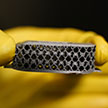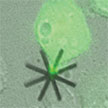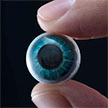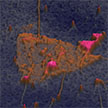Showing Spotlights 33 - 40 of 233 in category All (newest first):
 Researchers have developed a sprayable on-site sensing tool. The main application area for this sensor spray is the detection of specific analytes in an environment where sample collection is a difficult task either due to the target chemicals themselves or the area where the samples are located. A nebulization method allows for nanofibers to be sprayed onto any surface, while the accompanying phone-based application allows for direct on-site detection.
Researchers have developed a sprayable on-site sensing tool. The main application area for this sensor spray is the detection of specific analytes in an environment where sample collection is a difficult task either due to the target chemicals themselves or the area where the samples are located. A nebulization method allows for nanofibers to be sprayed onto any surface, while the accompanying phone-based application allows for direct on-site detection.
Jun 27th, 2022
 Researchers propose a first-of-a-kind smart orthopedic implant with both diagnostic and energy harvesting capabilities. This mechanically tunable, multifunctional metamaterial implant can sense and harvest energy from body motions. These implants only use their constituent components to achieve these advanced functionalities - they don't require any external power source or bulky electronics. Furthermore, the implants can be 3D printed and customized for each patient based on the clinical requirements and anatomical matching.
Researchers propose a first-of-a-kind smart orthopedic implant with both diagnostic and energy harvesting capabilities. This mechanically tunable, multifunctional metamaterial implant can sense and harvest energy from body motions. These implants only use their constituent components to achieve these advanced functionalities - they don't require any external power source or bulky electronics. Furthermore, the implants can be 3D printed and customized for each patient based on the clinical requirements and anatomical matching.
Jun 3rd, 2022
 Researchers have designed a self-powered, 'one-terminal' tactile sensor that can distinguish various motions on a single electrode. They did this by using a thermoplastic polymer that can easily change the electrostatic signal in a selective area. The sensor array can perceive the position and the sequence of touches, shape of touching objects, and dynamic motions (sliding, rolling) of an object and can distinguish various motions on a single electrode.
Researchers have designed a self-powered, 'one-terminal' tactile sensor that can distinguish various motions on a single electrode. They did this by using a thermoplastic polymer that can easily change the electrostatic signal in a selective area. The sensor array can perceive the position and the sequence of touches, shape of touching objects, and dynamic motions (sliding, rolling) of an object and can distinguish various motions on a single electrode.
May 6th, 2022
 The mechanical properties of cells and their intracellular mechanical loads are as relevant for a cell's accurate functioning as the biochemical portion of the cell. This offers a novel perspective that addresses the study of cell mechanics and even the alteration of the mechanical equilibrium of the cells by using silicon chips as an intracellular intervention mechanism. These 'echanical drugs' open the possibility to determine and measure intracellular forces and internalization routes. They can also produce intracellular mechanical perturbations by altering the cell cycle and even, if they are designed accordingly, destroy the cells.
The mechanical properties of cells and their intracellular mechanical loads are as relevant for a cell's accurate functioning as the biochemical portion of the cell. This offers a novel perspective that addresses the study of cell mechanics and even the alteration of the mechanical equilibrium of the cells by using silicon chips as an intracellular intervention mechanism. These 'echanical drugs' open the possibility to determine and measure intracellular forces and internalization routes. They can also produce intracellular mechanical perturbations by altering the cell cycle and even, if they are designed accordingly, destroy the cells.
May 2nd, 2022
 Ongoing smart contact lens research ranges from biosignal detection (intraocular pressure, glucose, cortisol) to therapeutic tools (aniridia, chronic ocular inflammation) and advanced features such as aumented reality displays and personalized designs using 3D-printing technology. Some of these technologies are already finding their way from the lab into commercial applications. The development of next-generation, smart contact lens technology is not just simply one field of bioelectronics but rather a complex, interdisciplinary effort that includes development of biocompatible materials; development of intuitive interfaces; and development of integration technologies capable of smart contact lens research.
Ongoing smart contact lens research ranges from biosignal detection (intraocular pressure, glucose, cortisol) to therapeutic tools (aniridia, chronic ocular inflammation) and advanced features such as aumented reality displays and personalized designs using 3D-printing technology. Some of these technologies are already finding their way from the lab into commercial applications. The development of next-generation, smart contact lens technology is not just simply one field of bioelectronics but rather a complex, interdisciplinary effort that includes development of biocompatible materials; development of intuitive interfaces; and development of integration technologies capable of smart contact lens research.
Apr 18th, 2022
 Resonance-based sensors can be used as an advanced tool for gas sensing as they show several advantages as compared to conventional gas sensors like metal-oxide semiconductor and electro-chemical gas sensors. With the introduction of an additional metamaterial layer over the sensor, the selectivity of these sensors can be improved. These article focuses mainly on metamaterial-based split ring resonators (SRR) and complementary SRRs (CSRRs) structures used in several sensing applications.
Resonance-based sensors can be used as an advanced tool for gas sensing as they show several advantages as compared to conventional gas sensors like metal-oxide semiconductor and electro-chemical gas sensors. With the introduction of an additional metamaterial layer over the sensor, the selectivity of these sensors can be improved. These article focuses mainly on metamaterial-based split ring resonators (SRR) and complementary SRRs (CSRRs) structures used in several sensing applications.
Apr 7th, 2022
 Conventional skin electronics are fixed designs that lack consideration for the individual characteristics of the wearer as well as the ability to actively adapt to various user specifications. In order to manage different sensor specifications and body impedances, design adjustments are inevitable during fabrication of these devices. To address this issue, researchers have developed a real-time fabrication platform that can adapt to arbitrary environments by freely drawing or erasing paths in a printed circuit.
Conventional skin electronics are fixed designs that lack consideration for the individual characteristics of the wearer as well as the ability to actively adapt to various user specifications. In order to manage different sensor specifications and body impedances, design adjustments are inevitable during fabrication of these devices. To address this issue, researchers have developed a real-time fabrication platform that can adapt to arbitrary environments by freely drawing or erasing paths in a printed circuit.
Feb 3rd, 2022
 A novel multidimensional characterization approach that combines several characterization techniques, allowing to get materials properties of the heterostructure with (almost) nanometer resolution. The method combines several microscopy tools into a multidimensional imaging tool that allows the inspection of materials' optical properties at a resolution much higher than with regular optical microscopy. At the core of this method are nanometer-resolution optical maps that we obtained with scattering Scanning Near-field Optical Microscopy (sSNOM).
A novel multidimensional characterization approach that combines several characterization techniques, allowing to get materials properties of the heterostructure with (almost) nanometer resolution. The method combines several microscopy tools into a multidimensional imaging tool that allows the inspection of materials' optical properties at a resolution much higher than with regular optical microscopy. At the core of this method are nanometer-resolution optical maps that we obtained with scattering Scanning Near-field Optical Microscopy (sSNOM).
Jan 22nd, 2022
 Researchers have developed a sprayable on-site sensing tool. The main application area for this sensor spray is the detection of specific analytes in an environment where sample collection is a difficult task either due to the target chemicals themselves or the area where the samples are located. A nebulization method allows for nanofibers to be sprayed onto any surface, while the accompanying phone-based application allows for direct on-site detection.
Researchers have developed a sprayable on-site sensing tool. The main application area for this sensor spray is the detection of specific analytes in an environment where sample collection is a difficult task either due to the target chemicals themselves or the area where the samples are located. A nebulization method allows for nanofibers to be sprayed onto any surface, while the accompanying phone-based application allows for direct on-site detection.
 Subscribe to our Nanotechnology Spotlight feed
Subscribe to our Nanotechnology Spotlight feed





